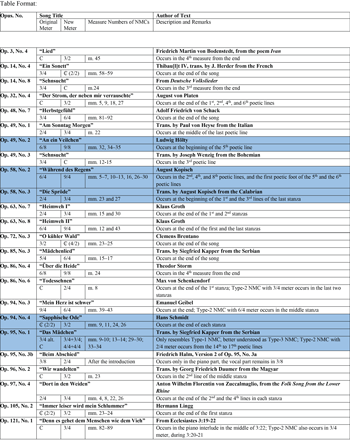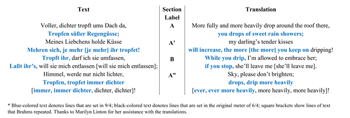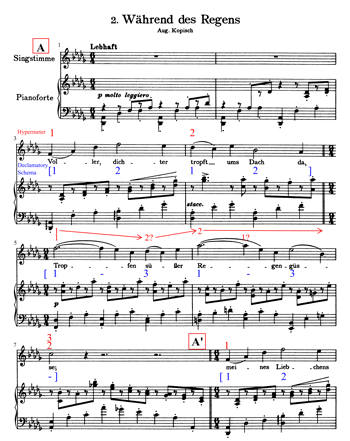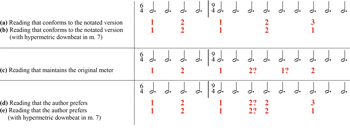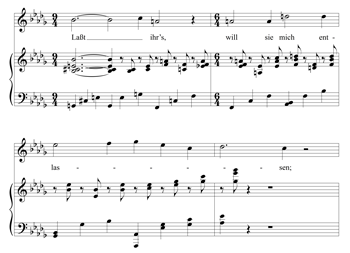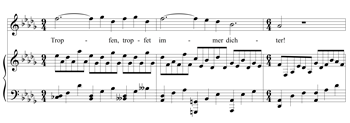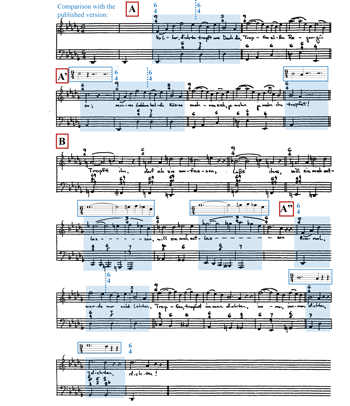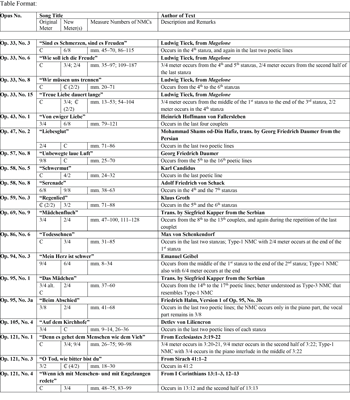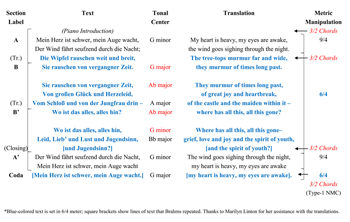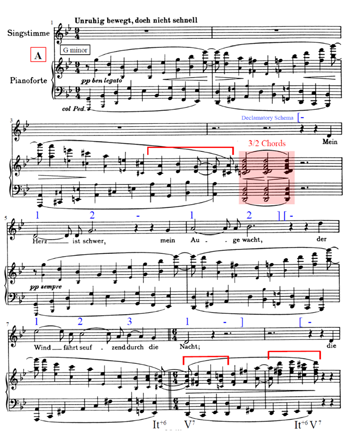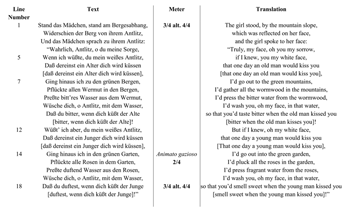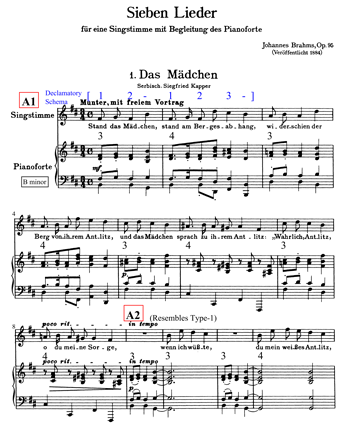Composing Declamation: Notated Meter Changes in Brahms’s Lieder *
Wing Lau
KEYWORDS: rhythm and meter, notated meter change, Brahms, Lieder, text-music relations, analysis and performance
ABSTRACT: This article offers a new perspective on the function and expressive effect of notated meter changes in Brahms songs—a topic that has gone largely unexplored in current scholarship on rhythm and meter. A close analysis of the notated meter changes in Brahms’s “Während des Regens,” op. 58, no. 2, “Mein Herz ist schwer,” op. 94, no. 3, and “Das Mädchen,” op. 95, no. 1, reveals how much his careful attention to the notated meter reflects his sensitivity to the pacing of music and words. Drawing upon poetic prosody and metric analysis, this article shows how this pervasive but underexamined aspect of Brahms’s songwriting style relates to both the sound and sense of the poems he sets.
Copyright © 2015 Society for Music Theory
[1] Over the past thirty years, Brahms’s manipulation of musical meter has been a key topic in discussions of rhythm and meter. Scholars such as David Lewin (1981), Richard Cohn (2001), Ryan McClelland (2006, 2010), Scott Murphy (2007, 2009), and Samuel Ng (2005, 2006) have explored the relationship between Brahms’s metric practices and his treatment of harmony, form, and other musical processes, focusing on his instrumental music. In more recent years, a number of scholars—including Deborah Rohr (1997), Harald Krebs (n.d.), Heather Platt (2012, n.d.), and Yonatan Malin (2010, 2012)—have turned their attention to metric manipulation in Brahms’s vocal music, considering how his inventive handling of rhythm and meter relates to text expression and declamation.(1) These works have mostly focused on metric manipulation within passages that remain in the same notated meter. However, the actual changes of meter in Brahms’s songs are no less common—41 of his 194 songs for solo voice with piano accompaniment involve notated meter changes, hereafter referred to as NMCs.(2) Nor are they any less central to his musical language. As with his experiments with grouping and displacement dissonance, Brahms’s fascination with NMCs is a sign of his sophisticated approach to the shaping of musical time and pulsation.(3) Brahms’s NMCs, in other words, are not merely cosmetic details; rather, as we will see, they often have far-reaching expressive implications.
[2] In this article, I provide an overview of three types of NMC in Brahms’s solo songs. The first type involves a brief appearance of a new meter, the second involves different meters for different sections corresponding to different affects, and the third involves a quick and regular alternation between triple and duple or quadruple meters. (The three types of NMC are not mutually exclusive; a number of songs demonstrate more than one type.)(4) The NMCs in Brahms’s songs alter the ordering of strong and weak musical beats, create hypermetric ambiguity, and at the same time enable Brahms to vary the pace of poetic declamation for expressive purposes. In all of these cases, NMCs generate a different sense of motion and emotion.
[3] In what follows, I address each type of NMC in turn, starting with general comments and then exploring a specific case study. These case studies include “Während des Regens,” op. 58, no. 2 for Type 1; “Mein Herz ist schwer,” op. 94, no. 3 for Type 2; and “Das Mädchen,” op. 95, no. 1 for Type 3 (although this song also involves Type 2 and passages that resemble Type 1 ).(5) At the end of each case study I provide samples of two or three recordings to allow for comparison of performers’ different interpretations of NMCs. The visual effect of a new meter seems to have a particularly strong impact on performers’ interpretations. As David Epstein points out, in passages with displacement dissonances it is the performers who need to “conceptualize” and “struggle” with the contradictory notational and phenomenal accents (1990, 204). A different form of struggle emerges when performing passages with NMCs—not only because of the visual dissonance of the meter changes on the score, but also because of the indirect metric dissonances generated at the beginning of the new notated meters.(6) The performer and listener inwardly continue the previous notated metric pulsation as the new one begins, so that “there arises a brief but clearly perceptible conflict between the mentally retained first [metric] layer and the actually sounding second [metric] layer” (Krebs 1999, 45). In the case of NMCs, the second metric layer is not just a “sounding” one, but also a manifestly visual one. By visually as well as aurally shifting the metric organization of a song, NMCs not only generate new declamatory patterns; they also direct performers to certain moments of musical accentuation and punctuation that might have otherwise gone unnoticed. NMCs therefore reinforce Malin’s observation about Brahms’s scores in general: they “dictate aspects of temporal flow that typically fall in the hands of the performer” (2010, 154). This prevalent but understudied phenomenon, in other words, has profound implications for both analysis and performance.
Type-1 NMCs: A Brief Appearance of a New Meter
Example 1. Songs with Type-1 NMCs
(click to enlarge)
Example 2. The end of “Lied,” op. 3, no. 4
(click to enlarge)
[4] The first type of NMC, a relatively brief appearance of a new meter, is the most common—58.54% of Brahms’s songs with NMCs (24 out of 41) feature a Type-1 example, all of which are listed in Example 1 (blue highlighting on the table indicates songs that belong to a subcategory that I will address in paragraph [6]). This type of meter change is often short-lived, ranging from one measure to as many as five or six measures.(7) It contributes to the shift of declamatory patterns, creating new strong (or weak) beats over specific words. By lingering on a specific vowel or syllable, Brahms is able to emphasize words that resonate with the emotional content of the poem. Musically, Type-1 NMCs allow for a certain hypermetric flexibility. Structurally, this type of NMC can also help to create a transition between sections with different tempi. Most commonly, though, the effect of Type-1 NMC is rhetorical; this type of meter change is comparable to a composed-out ritardando, rubato, or ritenuto at an emotional climax or prior to the close of a piece.(8)
[5] Type-1 NMCs commonly function as composed-out decelerations either by adding beats or note values.(9) Example 2, from the end of Brahms’s “Lied,” op. 3, no. 4, contains a composed-out ritenuto, a more sudden type of deceleration than the gradual deceleration of a composed-out ritardando (and a comparatively rare effect found more often in Brahms’s music than in the music of other composers [Rothstein 1989, 81]). The square in the example indicates the ![]()
Case Study: “Während des Regens,”op. 58, no. 2
[6] Other songs of Brahms are pervaded by multiple short-lived meter changes (highlighted in blue in Example 1). “Während des Regens,” op. 58, no. 2, is one of the more extreme examples. Throughout the song, the duration of a beat is kept as a dotted half note, but the new compound triple meter alternates rapidly with the original compound duple meter, generating a constant stretching and compression of the felt musical pulse. The alternation creates a sense of musical ebb and flow and significantly undermines the original meter, in addition to heightening the protagonist’s subtle changes in emotion throughout the song: from excitement in the present time, to fear for the undesirable future, and back to indulgence in the present moment.
Example 3. Text and translation of “Während des Regens,” op. 58, no. 2
(click to enlarge)
[7] The song is written in
Example 4. “Während des Regens”
(click to enlarge and see the rest)
[8] The use of
Example 5. Five Different Hypermetric Readings of “Während des Regens,” mm. 3–7
(click to enlarge)
[9] The multiple short-lived NMCs and the resulting changes in declamatory schema add to the ambiguous hypermetric structure in “Während des Regens,” which juxtaposes duple and triple hypermeasures, as shown by the two layers of red-colored hypermetric numbers in Example 4. Dotted lines between hyperbeat numbers indicate expanded hyperbeats due to expansions of individual harmonies in mm. 17–23 and 32. Square brackets, as in mm. 20–23, indicate restatement of hyperbeats due to text repetition and harmonic instability.(14) In the initial A section (mm. 1–7), the top layer of hypermetric numbers (also shown in Example 5a without the score) indicates a reading that adheres to the notation. The lower layer (also shown in Example 5c) displays an alternate reading that maintains the
[10] As shown in Example 5, the hypermetric ambiguity is enhanced by the different durations of the hyperbeats (the hyperbeats in the 3-bar hypermeasures are a dotted half note longer than those in the 2-bar hypermeasures). My hypermetric reading in
Example 5b indicates that the last hyperbeat in the A section can be perceived as a hypermetric downbeat because of the established duple hypermetric pulse and the strong arrival of the tonicized half cadence in m. 7.(15) Example 5c adheres to the original meter as if one were listening without the score and unaware of the new meter. The declamatory schema in mm. 5–7 without the meter change would have been [1 – / 1 2 / – 2 / 1] (bold typeface refers to the notated metric accent), creating two triple groupings spanning the duration of three duple groupings.(16) However, the placement of hyperbeat 1 in m. 6.2 is unconvincing due to the weakened metric and harmonic stresses: ![]()
[11] These different layers of interpretation and the indefinite hypermetric periodicity paint a lighthearted atmosphere fitting for a scene about a lover’s tryst. From another standpoint, the triple metric and hypermetric groupings challenge the duple ones, hinting at a subtle difference between what is actually happening in the poem and what the protagonist wishes to continue happening. Put simply, the number of beats in the bar and the number of bars in a hypermeasure increase from duple to triple as the rain and kisses increase, which in turn relaxes the declamation and stretches musical time. Together with the almost luxurious lingering on the high F5 and
[12] The B section projects the protagonist’s concern about the rain stopping, and we see an NMC that goes in the opposite direction from the previous one—not a
Example 6. Hypothetical recomposition of mm. 16ff. of “Während des Regens”
(click to enlarge)
[13] The text declamation and hypermetric regularity in the second half of the B section are further complicated by text repetitions and dissonant harmonies, shown by the two layers of hypermetric analysis from m. 17 onwards in Example 4. The top layer adheres to the notated meter of
[14] Unlike the similar lengthening in the previous A sections, the B section lengthens musical time only at the level of the hypermeasure, not at the level of the hyperbeat. But it is precisely the presence of these shorter
Example 7. Hypothetical recomposition of mm. 26ff. of “Während des Regens”
(click to enlarge)
[15] The original NMC order of
Example 8. George Bozarth’s reconstruction of “Während des Regens” based on an earlier Brahms sketch (adapted from Bozarth 1978, 209a)
(click to enlarge)
[16] “Während des Regens” is one of few songs by Brahms with a surviving sketch, currently located at the Gesellschaft der Musikfreunde in Vienna. George Bozarth (1978, 109a, 111–12) reconstructed a hypothetical earlier version of the song based on the corrections marked on Brahms’s surviving sketches, as shown in Example 8 (see my comparison with the published version, marked in blue).(22) This reconstruction suggests that Brahms initially had different NMCs in mind from those found in the published version of the song, which relies heavily on
[17] The other significant change Brahms made in the published version is the metric and phrase expansion created by the changes from
[18] NMCs have an impact not only on listeners but also on performers. Analytical listening to different recorded performances of “Während des Regens” offers insight into differing interpretations of Brahms’s NMCs. I have compared two recordings that demonstrate distinct interpretations, especially in the performers’ articulations and subtle inflections. Audio Example 1 is a recording by soprano Antonia Bourvé and pianist Tobias Hartlieb, and Audio Example 2 is a recording by baritone Dietrich Fischer-Dieskau and pianist Daniel Barenboim.
Audio Example 1. Recording by soprano Antonia Bourvé and pianist Tobias Hartlieb
Audio Example 2. Recording by baritone Dietrich Fischer-Dieskau and pianist Daniel Barenboim
[19] Of these two recordings, the first demonstrates fewer changes in articulation. Bourvé sings the entire song with a smooth legato articulation that floats over the fluid staccato in the piano. She increases her vibrato as she sings the high
[20] Dietrich Fischer-Dieskau and Daniel Barenboim take a very different approach by using a slightly faster tempo and a wider range of articulations. Fischer-Dieskau sings the first
Type-2 NMCs: Different Meters for Different Sections Corresponding to Different Affects
Example 9. Songs with Type-2 NMCs
(click to enlarge)
Example 10. Excerpts with Type-2 NMC from Brahms, op. 33, nos. 6 and 8
(click to enlarge)
Example 11. Text of “Mein Herz ist schwer,” op. 94, no. 3
(click to enlarge)
[21] Example 9 lists Brahms’s songs that demonstrate the second type of NMC: different meters for different sections corresponding to different affects; these songs comprise 46.34% of all songs with NMCs (19 out of 41).(26) Type-2 NMCs reflect not only poetic affect but also poetic structure. Depending on the poem, the transitions between the two notated meters are sometimes clear but sometimes not. These transitions are most obvious when they involve a Type-1 NMC, hypermetric irregularity, and grouping or displacement dissonance. However, an obvious change of note values, dynamics, or tempo markings, as well as the inclusion of a piano interlude, may also contribute to a clear transition between notated meters. The presence of these transitions tends to be more noticeable if more of these criteria are met. Inevitably, there is also some degree of interpretation involved. For the purposes of this article, I will focus on transitions that involve hypermetric irregularity and grouping or displacement dissonance. Other songs with less obvious transitions between NMCs generally involve texts with a dramatic narrative, especially those from a song-cycle-like collection. For instance, four songs with relatively sudden Type-2 NMCs come from Brahms’s Romanzen aus Magelone, op. 33, settings of texts by Ludwig Tieck. All fifteen songs in the set are originally poems interspersed in Tieck’s short novel.(27) The four songs with sudden Type-2 NMCs depict four life-changing moments of the main character, Peter, and his beloved Magelone. Example 10 shows excerpts of op. 33, nos. 6 and 8, which contain two of these moments: the first being the moment right before the couple’s first meeting, the latter being the moment before the couple elope together. The analysis below, “Mein Herz ist schwer,” op. 94, no. 3, reveals a clear transitional passage between the two notated meters by means of metrical and hypermetrical ambiguity. Throughout the song, different metric environments correspond to the different emotions of the protagonist as his mind travels back and forth through time.
Case Study: “Mein Herz ist schwer,”op. 94, no. 3
[22] “Mein Herz ist schwer” is a setting of Emanuel Geibel’s poem of the same title. The poetic line repetitions suggest some internal symmetry, which is enhanced in Brahms’s setting by different quasi-symmetrical musical structures with different twists. In the following discussion, I first examine the elements that contribute to the quasi-symmetry—the form, the use of NMCs, and the tonal areas—and then continue to the elements that do not contribute to (or even disrupt) the symmetry—line 10 and the coda, for example.(28)
[23] The text, translation, and a comparison of the poetic and musical structures are shown in Example 11. The square brackets in the example indicate the text repetitions that were added by Brahms. The blue-colored lines are set in
[24] Brahms’s NMCs conform to the symmetrical elements of the poem and enhance the cyclic poetic meaning, not because the sections of the song correspond with the stanzas of the poem, but because Brahms underlines the poem’s repeated lines with section changes and meter changes. “Mein Herz ist schwer” is set as a ternary form, ABB′A′ plus a coda. The repeated outer couplets form the outer A sections, both of which are set in G minor, with a triple meter of
[25] A Type-2 NMC marks the start of the B section, coinciding with the text repetition across stanzas 1 and 2. These lines initiate a chromatic tonal ascent, moving from G major to
Example 12. “Mein Herz ist schwer”
(click to enlarge and see the rest)
[26] The poem is written mostly in a regular iambic tetrameter (four weak-strong poetic feet per line), except for line 10. However, the switch from a triple to duple meter in Brahms’s setting, shown in Example 12, decreases the number of metrical weak beats that occur between metrical strong beats, resulting in a subtle acceleration (mm. 14ff., similar to mm. 13–15 of “Während des Regens”). The slower declamation in section A is further intensified by Brahms’s inserted rests between mm. 5 and 6, which reflect the commas in poetic line 1. These rests within a poetic line are absent in later sections but reappear in the coda. The resulting declamatory schema [1, 2 – / 1, 2 –] [1 , 2, 3 / 1 –] in mm. 5–8 is overlaid on the score, marked in blue. Malin describes this particular “combined couplet schema” as a pattern that enables a downbeat cadence: “There is tension in the first-line setting as the second beat competes with the first for priority; the second-line setting then resolves this tension” (2010, 51). In mm. 5–6, this schema creates a dragging effect as the protagonist describes his present restless and sleepless condition: “Mein Herz ist schwer, mein Auge wacht” (my heart is heavy, my eyes are awake).(30) This tension is relaxed for a slight moment as the protagonist turns his focus to the sighing wind in mm. 7–8: “der Windfährt seufzend durch die Nacht.” The renewed energy from his past memory is portrayed by a faster and more direct [1, 2 / 1, 2] schema throughout the two B sections in
[27] The effect of the Type-2 NMCs is reinforced by the piano figuration and the corresponding harmony. The outer A sections, for example, are tonally stable in the key of G minor, but accompanied by two rhythmically interlocking arpeggios that move in contrary motion between the two extremes of the keyboard (another symmetry). As a result the accompaniment does not settle in any register until the fourth measure—but even that stasis is disrupted by a moment of metric grouping dissonance: the syncopated D7 chords suggest
[28] Another key metric manipulation in this song involves grouping and displacement dissonance, which Brahms uses to generate temporal suspense in order to transition between sections with triple and duple meter. I will focus on the “
[29] In an unpublished paper, Heather Platt (n.d.) describes all of these grouping dissonances as lying on a “slower temporal plane,” in which the protagonist “is held captive, frozen in a past time.” The grouping dissonances also freeze the rate of declamation and create disruptions between sections with different pacing. In this way, these grouping dissonances not only help to lead from one section (and one meter) to another; they also reflect the protagonist’s thoughts, which travel from the present to the past, from one time to another.
[30] Despite the quasi-symmetrical elements in “Mein Herz ist Schwer,” occasional disruptions to the symmetry intensify the melancholic isolation in the song. The Type-1 NMC in mm. 39ff. and the final appearance of the syncopated chords allow for a deceleration, and function as a short coda. The additional text repetition and ambiguous tonal center in this coda offset the symmetry discussed thus far. The double neighbor figure in m. 4 (all occurrences are marked by red brackets in Example 12) that closes the piano introduction and introduces the syncopated chords becomes a crucial motivic gesture in mm. 7–8, coinciding with the It.+6–V7 half cadence in the key of G. The same motivic gesture in mm. 38–40 leads to another half cadence, preceded by the same progression in mm. 37–38, hinting at the tonic G as the new dominant. But the new implied tonic (C major/minor) never materializes,(33) a tonal twist that is unprecedented in the song. The text repetition in the coda (mm. 39ff.) uses the same declamatory schema as the hypermetric tunnel in mm. 10ff. instead of the one in mm. 37–38. This stasis again freezes the temporal flow. The added rests in the middle of mm. 39 and 40 resemble heavy breathing from exhaustion, particularly since the first rest does not correspond to any punctuation in the text. All of these final twists to the quasi-symmetry—Type-1 NMC, text repetition, new-found tonal ambiguity, and new declamatory schema—result in a dramatic loss of energy and create a despondent effect, further enhancing the cyclic return of the melancholic protagonist’s heartache.
[31] One more non-symmetrical aspect of the song is line 10 (mm. 27–28), the only poetic line not written in clear iambic tetrameter, and the only part of the song where the singer shares the grouping dissonance with the piano accompaniment. This line follows the second text repetition (lines 8 and 9) and continues the question about the irretrievable past: “LEID, LIEB’ und LUST und JUgendSINN” (“grief, love, and joy, and the spirit of youth”—capitalized syllables indicate poetic stresses, italics indicate syllables that can be read as either stressed or unstressed). “LIEB” can be read as either part of a spondee (strong-strong—“LEID, LIEB’”) or part of an anapest (weak-weak-strong—“Lieb’ und LUST”). The vocal line in mm. 27–28 is a displaced version of the grouping dissonance found in the piano part in m. 16 (see the highlighted section in Example 12), generating a syncopated schema [a / – a?, 2 / 1, 2] (“a” stands for an accented syllable on the second half of a beat; the question mark on “a?” suggests its interpretive flexibility). Not only does the declamatory schema of line 10 differ from the foregoing lines, but its tonal center
Example 13. Tempo Changes in Three Recordings of “Mein Herz ist schwer”
(click to enlarge and listen)
[32] The visual cues for metric dissonances in the score—the constant metric displacements between the pianist’s right and left hands, the syncopated block chords, and the NMCs that signal new sections and changes of emotion—can yield different performance interpretations. Performances of “Mein Herz ist schwer” differ mainly with respect to the emotional intensity of the B section and the overall choice of tempo. The three recordings sampled are listed in Example 13 (Audio Example 3: baritone Michael Nagy with pianist Helmut Deutsch; Audio Example 4: bass-baritone Daniel Lichti and pianist Janina Fialkowska; and Audio Example 5: baritone Dietrich Fischer-Dieskau and pianist Daniel Barenboim). All three performances slow down during the displaced syncopated chords around mm. 10–13, thereby enhancing the sense of suspension. They then consistently speed up approaching the B′ section, underlining the protagonist’s sense of defiance as he asks “Wo ist das Alles hin?” They also take the A′ section slower than the initial A section, as if the protagonist is exhausted from the present suffering and the memory of his lost youth.
[33] Overall, Nagy chooses a slower and steadier tempo than the others, which allows him to take great care in articulating each consonant and vowel. As shown in Example 13, Lichti’s range of tempo is the widest. The large-scale flexibility in performance timing is also reflected on a smaller scale in his approach to rhythm. He elongates most of the eighth notes and pays great attention to creating a smooth legato line. However, this melodic fluency is never applied to the words “Mein Herz ist schwer, mein Auge wacht.” Instead, he always articulates the comma in the middle of this poetic line (mm. 5–6 and 37–42) with an audible breath, as if the protagonist were having difficulty in breathing because of his heavy heart. Fischer-Dieskau’s performance of “Mein Herz ist schwer,” like his recording of “Während des Regens” in Audio Example 2, demonstrates a variety of tone qualities, at times using an almost speech-like voice, prioritizing declamation over pitch accuracy. His speech-like intonation in m. 20 (“Herzeleid”) turns immediately into a whispering voice in mm. 20–21 (“Vom Schloß”). He then emphasizes the initial consonants of the words “hin” and “Jugendsinn”—highlighted in bold typeface—with a throat-heavy sound in mm. 24 and 29, creating the impression of a passionate outburst.
Type-3 NMCs: Quick and Regular Alternation of Triple and Duple (or Quadruple) Meters
[34] The third type of NMC involves two time signatures at the beginning of the piece, one triple and one duple or quadruple. Generally, these two notated meters alternate regularly measure-by-measure. As Rohr (1997, 258) and the pianist Lucien Stark (1995, 287) have noted, this composite meter (or mixed meter) is typical of Hungarian, Slovakian, and Bohemian dances.(34) In his solo Lieder, Brahms employs the meter when setting folk or folk-like texts.
Example 14. Songs with Type-3 NMCs
(click to enlarge)
[35] As shown in Example 14, two of Brahms’s songs present this type of NMC: “Agnes,” op. 59, no. 5 and “Das Mädchen,” op. 95, no. 1. Edwin Evans (1912, 427) explains that the presence of two meters instead of a single (non-isochronous) meter that combines them frees the composer from maintaining a regular pattern (such as 3+4 or 4+3)—a metrical freedom explored in both songs. In the first song, “Agnes,” the poem is a folk-inspired lament that “falls into a traditional poetic archetype” according to Rohr (1997, 260). Brahms’s choice of a composite meter typical in some folk music,
Case Study: “Das Mädchen,”op. 95, no. 1
Example 15. Text and translation of “Das Mädchen,” op. 95, no. 1
(click to enlarge)
Example 16. The Score of “Das Mädchen”
(click to enlarge and see the rest)
[36] “Das Mädchen” is through-composed with some traces of a modified strophic form and a contrasting middle section. Example 15 provides the text and translation (square brackets indicate text repetitions added by Brahms).(37) Poetic lines 1–3 introduce a maiden standing on a mountain slope addressing her own face; from line 4 onwards, the singer takes on the role of the maiden and talks about her possible sad future being kissed by an old man (lines 5–6). In Example 16, the annotated score, alternating meter pervades these sections (labeled A1 and A2) and yields an asymmetrical arrangement of beats: 1 2 3, 1 2 3 4, 1 2 3, 1 2 3 4. The numbers in black between the staves of Example 16 indicate the number of beats in each measure. Brahms’s alternating meter maps perfectly onto the asymmetrical poetic structure: the poem is written in trochaic pentameter (five strong-weak poetic feet per line), and the five stresses per line are mostly grouped 2+3, as suggested by the comma in “Stand das Mädchen, stand am Bergesabhang.” Brahms’s use of composite meter not only correlates the odd-numbered poetic stresses with odd-numbered musical ones, but also intensifies the poetic punctuation with a musical one, as expressed in the declamatory schema [1, 2 – / 1, 2, 3 –] (shown with blue-colored numbers in mm. 1–2 of Example 16).
[37] Brahms’s setting of pentameter lines in “Das Mädchen” somewhat differs from Schubert’s. In an important study, Fehn and Hallmark (2010, 155–219) categorize Schubert’s strategies for setting pentameter lines of poetry. One of his procedures (which Fehn and Hallmark label “X”) is to compress two poetic feet so that the line can fit into four metric units. Another procedure (labeled “Y”) is to set all five poetic feet to even units of musical time and add a rest at the end, yielding six metric units for the line. Thus, Schubert normally sets pentameter lines to even-numbered groups of metric units.(38) Brahms’s setting of the opening pentameter lines of “Das Mädchen,” however, preserves the short-long metrical pattern of the text. This pattern is reinforced by the repetitive vocal line, doubled by the piano’s block chords that add a rustic and percussive flavor. The text suggests both physical and emotional imbalance, which Brahms enhances with a slight tonal imbalance, a brief and abrupt shift to D major in mm. 3–4, the relative major of the overall tonic B minor. This kind of oscillation between relative keys is a common trait of much folk music. The physical imbalance comes from standing on a cliff face, as described in poetic lines 1–3 (set as mm. 1–8). The emotional imbalance comes from the protagonist’s worry that her beauty will attract an old suitor (poetic lines 4–6, mm. 9–16 of the music, which is also characterized by a recitative-like texture and Type-1 NMCs), and her plans to dissuade or even disgust the old suitor (poetic lines 7–11, mm. 17–28, marked as section A3). This espressivo section hints at the subdominant key of E minor, with less energetic accompaniment and slower harmonic rhythm as the girl is plotting. The opening piano accompaniment and faster harmonic rhythm gradually resume as her plan becomes clear in mm. 25ff.—she will wash her face with bitter water before the old man kisses her (“daß du bitter, wenn dich küßt der Alte”). This skillful use of alternating musical meter not only preserves the poetic meter and contributes a folk flavor, but also traces the deeper emotion of the protagonist.
[38] The contrasting B section in m. 37, marked as animato grazioso, shares some motivic and rhythmic similarity with the A sections, for example the use of the melodic second
[39] I will now examine passages in this song that resemble a Type-1 NMC (the brief appearance of a new meter): the two analogous passages at mm. 9–14 and 29–34 that depict the instances when the girl starts projecting her two possible futures (sections A2 and A2′). The temporal fluctuation in these two passages is artfully composed-out. In m. 8, the poco rit. and diminuendo suggest a slower and less energetic declamation. In mm. 9 and 11 (both parallel to m. 1), the piano takes the center stage. It re-establishes both the tonic chord and the previous tempo, and hints at a false return of the earlier A1 section. However, these measures intermingle with the triple meter in m. 10 and the quadruple meter in m. 12 of the vocal line, creating a varied version of the opening measures. The metric order of 3+3 in mm. 9–10 resembles a Type-1 NMC, for it falls in a grey area between NMC and non-NMC. These attempts to re-launch the A section are metrically ambiguous if not suspended.(39) This weakened metrical grounding is comparable to the effect of rubato or ad lib., except that such temporal adjustments are composed into the song instead of being written out as verbal instructions, as in m. 8. This metrical hesitation and uncertainty reflect the hesitation of the protagonist: “Wenn ich wüßte, du mein weißes Antlitz” (if I knew, you my white face).
[40] The next poetic line (line 6) accelerates the rate of declamation and creates a composed-out acceleration. The piano in m. 13 repeats m. 2, echoed by the voice in the second half of the bar. This succession of duple groupings hastens the declamation and leads to the recoup of the composite meter in mm. 14–16. With the help of the crescendo and the return of the composite meter, the momentum of the composed-out acceleration is intensified to the extent that it over-compensates for the metric suspense in mm. 9–12.(40) This overdrive contrasts with the uncertainty in poetic line 5 and enhances the maiden’s agitation: “Daß dereinst ein Alter dich wird küssen” (that one day an old man would kiss you). The analogous passage, the later A2′ section in mm. 29–34 (poetic lines 12–13) is set in major and projects a totally different mood in preparation for the Animato grazioso section in
[41] The interpretive challenges of performing “Das Mädchen” lie partly in the choice of tempo in the animato grazioso section. I sample two recordings that are representative of distinct styles: Jessye Norman with the pianist Daniel Barenboim (Audio Example 6) and Bernarda Fink with the pianist Roger Vignoles (Audio Example 7). Jessye Norman takes a relatively fast tempo throughout the song, and an even faster tempo at animato grazioso, giving the newly consistent metric pulse a dancelike quality. In contrast, Bernarda Fink takes the song slower than Norman does, and without much change in tempo at animato grazioso. Fink’s choice of tempo in the contrasting section projects a relaxing atmosphere when compared with the opening imbalanced alternation of meters.
Audio Example 6. Recording by Jessye Norman and pianist Daniel Barenboim
Audio Example 7. Recording by Bernarda Fink and pianist Roger Vignoles
[42] In general, Norman reacts to the meter changes by obvious fluctuations in tempo. She slows down significantly in m. 8, and responds sensitively to the metric ambiguity in mm. 9–12: she sings these four measures as if the meter were barely present. She speeds up again into m. 16, but stretches musical time in m. 17. This constant ebb and flow in tempo continues throughout her performance. She takes on an even faster tempo in the very last section (mm. 61–66), capturing the excitement of the maiden. Fink, on the other hand, shapes her performance with varying articulations rather than employing tempo fluctuation. For instance, the word “Alte” (old man) gets progressively heavier through the first half of the song. In m. 28, “Alte” sounds throat-heavy, as if she were shouting the word out loud. A similar interpretive change of articulation appears on the word “bitter.” In m. 30 she lingers on the word “aber” (but), signaling the maiden’s change of thought. Her animato grazioso passage has no sense of rushing, as if Fink herself were enjoying the moment, just as the text suggests. The last word of the song, “Junge” (young man), carries the same intensity as “Alte,” except that it is no longer throat-heavy, thus conveying the maiden’s joy.
Conclusion
[43] Studies have shown that Brahms adopted a flexible approach to interpretation, including a high degree of tempo variation and rhythmic inflection in his own performances, and accepting a wide range of interpretations of his own compositions (Avins 2003; Pascall and Weller 2003). As Styra Avins has pointed out: “[Brahms] understood the need for reliable, authentic editions, but he also understood that no edition could take the place of the experienced artist” (2003, 34). This is partly why there has been such extensive discussion of the various ways of performing Brahms’s metrically dissonant passages: the music seems to encourage a liberal approach to performance.(41) He was also skeptical about prescribing tempo, dynamic, and expressive markings in general, for they restrict the “free artistic performance” (Avins 2003, 23). Yet he was careful to provide clues for performers, mechanisms to direct the pacing of the music, the manner of declaiming texts, the shaping of a melodic line. Brahms’s NMCs are clear examples of these kinds of performance directives. Their frequent appearances in songs (or more generally, music that is based on an existing text such as his Chorale Preludes) provide clear visual clues that map metric accents onto the key words of a poem, and that generate different metric “flows” and different types of text declamation, often with the aim of conveying the subtle emotional shifts of the poetic persona. All of these observations support Malin’s argument that Brahms’s songs are “musical performances of poetic readings” (2010, 152)—they are realizations of the existing texts. Future studies relating to Brahms’s NMCs might focus on exploring specific mappings of time signatures and character-tempo markings, refining subcategories within each type (i.e., different forms of transformation between different meters); and investigating the implications of NMCs in his instrumental music. By paying attention to this striking and pervasive aspect of Brahms’s musical style, we can come to a deeper understanding of one of his most powerful ways of controlling musical pacing and expressing the subtle details of poetic structure and meaning.
Wing Lau
University of Oregon
School of Music and Dance
1225 University of Oregon
Eugene, OR 97403
wing@uoregon.edu
Works Cited
Avins, Styra. 2003. “Performing Brahms’s Music: Clues from his Letters.” In Performing Brahms: Early Evidence of Performing Style, edited by Michael Musgrave and Bernard D. Sherman, 11–47. Cambridge University Press.
Bozarth, George. 1978. “The ‘Lieder’ of Johannes Brahms—1868–1871: Studies in Chronology and Compositional Process.” PhD diss., Princeton University.
Brahms, Johannes. 1979. Complete Songs for Solo Voice and Piano: From the Breitkopf & Härtel Complete Works Edition. Dover Publications.
Cohn, Richard. 2001. “Complex Hemiola, Ski-Hill Graphs and Meric Spaces.” Music Analysis 20: 295–326.
—————. 1992. “The Dramatization of Hypermetric Conflicts in the Scherzo of Beethoven’s Ninth Symphony.” 19th-Century Music 15, no. 3: 188–206.
Epstein, David. 1990. “Brahms and the Mechanisms of Motion: The Composition of Performance.” In Brahms Studies: Analytical and Historical Perspectives, edited by George Bozarth, 191–226. Clarendon Press.
Evans, Edwin. 1912. Vocal Works. Vol. 1 of Historical, Descriptive, and Analytical Account of the Entire Works of Johannes Brahms. W. Reeves.
Fehn, Ann Clark, and Rufus E. Hallmark. 2010. “Text and Music in Schubert’s Settings of Pentameter Poetry.” In Of Poetry and Song: Approaches to the Nineteenth-Century Lied, edited by Jürgen Thym. University of Rochester Press.
Frisch, Walter. 1990. “The Shifting Bar Line: Metrical Displacement in Brahms.” In Brahms Studies, edited by George Bozarth, 139–163. Clarendon Press.
Ito, John Paul. 2013. “Hypermetrical Schemas, Metrical Orientation, and Cognitive-Linguistic Paradigms.” Journal of Music Theory 57, no. 1: 47–85.
Jacobsen, Christiane. 1976. “Das Verhältnis von Sprache und Musik in ausgewählten Liedern von Johannes Brahms, dargestellt an Parallelvertonungen.” PhD diss., Universität Hamburg.
Jenner, Gustav. 1990. “Johannes Brahms as Man, Teacher, and Artist.” Translated by Susan Gillespie. In Brahms and His World, edited by Walter Frisch, 185–204. Princeton University Press.
Krebs, Harald. (2012) n.d. “Expressive Declamation in the Songs of Johannes Brahms.” In Brahms and the Shaping of Time, submitted to the University of Rochester Press.
—————. 2009. “The Expressive Role of Rhythm and Meter in Schumann’s Late Lieder.” In A Music-Theoretical Matrix: Essays in Honor of Allen Forte (Part I), edited by David Carson Berry. Gamut 2, no. 1: 267–98. http://dlc.lib.utk.edu/web/ojs/index.php/first/index.
—————. 1999. Fantasy Pieces: Metrical Dissonance in the Music of Robert Schumann. Oxford University Press.
Lewin, David. 1981. “On Harmony and Meter in Brahms’s Op. 76, No. 8.” 19th-Century Music 4, no. 3: 261–65.
Malin, Yonatan. 2012. “‘Alte Liebe’ and the Birds of Spring: Text, Music, and Image in Max Klingr’s Brahms Fantasy.” In Expressive Intersections in Brahms: Essays in Analysis and Meaning, 53–79. Indiana University Press.
—————. 2010. Songs in Motion: Rhythm and Meter in the German Lied. Oxford University Press.
McClelland, Ryan. 2006. “Metric Dissonance in Brahms’s Piano Trio in C minor, Op. 101.” Intégral 20: 1–42.
McClelland, Ryan. 2010. Brahms and the Scherzo Studies in Musical Narrative. Ashgate Publishing Ltd.
Murphy, Scott. 2007. “On Metre in the Rondo of Brahms’s op. 25.” Music Analysis 26, no. 3: 323–53.
—————. 2009. “Metric Cubes in Some Music of Brahms.” Journal of Music Theory 53, no. 1: 1–56.
Ng, Samuel. 2006. “The Hemiolic Cycle and Metric Dissonance in the First Movement of Brahms’s Cello Sonata in F Major, op. 99.” Theory & Practice 31: 65–95.
—————. 2005. “A Grundgestalt Interpretation of Metric Dissonance in the Music of Johannes Brahms.” PhD diss., University of Rochester.
Pascall, Robert, and Philip Weller. 2003. “Flexible Tempo and Nuancing in Orchestral Music: Understanding Brahms’s View of Interpretation in his Second Piano Concerto and Fourth Symphony.” In Performing Brahms: Early Evidence of Performing Style, 220–43. Cambridge University Press.
Platt, Heather. n.d. “Temporal Disruption and Shifting Levels of Discourse in Brahms’s Lieder.” Unpublished Paper.
—————. 2012. “Brahms’s Mädchenlieder and Their Cultrual Context.” In Expressive Intersections in Brahms: Essays in Analysis and Meaning, 80–110. Indiana University Press
Riemann, Hugo. 1912. “Die Taktfreiheiten in Brahms’ Liedern.” Die Musik 12, no. 1: 10–21.
Rings, Steven. 2012. “The Learned Self: Artifice n Brahms’s Late Intermezzi.” In Expressive Intersections in Brahms: Essays in Analysis and Meaning, 19–50. Indiana University Press.
Rink, John. 1995. “Playing in Time: Rhythm, Meter and Tempo in Brahms’s Fantasien Op. 116.” In The Practice of Performance: Studies in Musical Interpretation, edited by John Rink, 254–82. Cambridge University Press.
Rodgers, Stephen. 2015. “The Fourth Dimension of a Song.” Music Theory Spectrum 37, no. 1.
Rohr, Deborah. 1997. “Brahms’s Metrical Drama: Rhythm, Text Expression, and Form in the Solo Lieder.” PhD diss., Eastman School of Music.
Rothstein, William. 1989. Phrase Rhythm in Tonal Music. Schirmer.
Sams, Eric. 2000. The Songs of Johannes Brahms. Yale University Press.
Schoenberg, Arnold. 1975. “Brahms the Progressive.” In Style and Idea, edited by L. Stein, translated by L. Black, 398–441. St. Martins Press.
Stark, Lucien. 1995. A Guide to the Solo Songs of Johannes Brahms. Indiana University Press.
Stein, Deborah and Robert Spillman. (1996) 2010. Poetry into Song: Performance and Analysis of Lieder. Forward by Elly Ameling. Oxford University Press.
Discography
Discography
Bourvé, Antonia, and Tobias Hartlieb. 2009. Johannes Brahms Complete Songs & Duets, vol. 12, Brilliant Classic, 93936, compact disc.
Fink, Bernarda, and Roger Vignoles. 2013. Brahms Lieder. Harmonia Mundi Gold, HMG 501926, compact disc.
Fischer-Dieskau, Dietrich, and Daniel Barenboim. 2009. Brahms Complete Edition, vol. 32 and 34, Deutsche Grammophon, DDD 0289 477 8183 7, compact disc.
Lichti, Daniel, and Janina Fialkowska. 1998. Daniel Lichti Sings Brahms and Schumann. Opening Day Recording, ODR9311, compact disc.
Nagy, Michael, and Helmut Deutsch. 2009. Johannes Brahms Complete Songs & Duets, vol. 13, Brilliant Classic, 93936, compact disc.
Norman, Jessye, and Daniel Barenboim. 2000. Brahms Lieder, vol.2, recorded 1981–82. Deutsche Grammophon 459 469-2, compact disc.
Footnotes
* I am grateful to Stephen Rodgers for providing comments on multiple earlier drafts of this article, and to Joon Park, Andrew Pokorny, and Tim Mastic for their proofreading assistance. Thanks also to Marilyn Linton for her help with all the German translations. Special thanks are due to Nicole Biamonte, the anonymous reviewers, and the editorial team of Music Theory Online.
Return to text
1. For an early discussion of rhythm and meter in Brahms’s songs, see Riemann 1912, 10–21.
Return to text
2. By “notated meter changes” I refer to the appearances of new time signatures in the middle of a piece. In the new metric system reflected by a notated meter change, the placement of strong beats may be repositioned, the number of weak beats may be altered, and the subdivision within each beat may be changed. These 194 songs with NMCs do not include the two songs from op. 91 (“Gestillte Sehnsucht” and “Geistliches Wiegenlied”), which include an obbligato viola, and op. 103 (“Zigeunerlieder”), which was written originally for SATB voice quartet with piano accompaniment.
Return to text
3. I borrow the terms grouping and displacement dissonance from Krebs (1999). Krebs defines grouping dissonance as “the association of at least two interpretive layers whose cardinalities are different and are not multiples/factors of each other” and displacement dissonance as “the association of layers of equivalent cardinality in a nonaligned manner” (1999, 31–33, 46).
Return to text
4. Of the 41 songs with NMCs, four (9.77%) demonstrate both Type-1 and Type-2 NMCs, and one (2.44%) demonstrates all three types of NMC.
Return to text
5. All the musical examples included in this article are reproduced from the Dover edition dated 1979. All the texts and English translations are adapted from Sams 2000.
Return to text
6. Krebs (1999, 45–46) distinguishes “direct dissonance”—the simultaneous superposition of different metric layers—from “indirect dissonance”—the diachronic juxtaposition of different metric layers. Krebs uses these terms to describe dissonances that occur in the context of a single notated meter; however, the term “indirect dissonance” could be applied to NMCs as well, since actual changes of meter often create an extreme form of indirect dissonance.
Return to text
7. Two songs demonstrate Type-1 NMCs for more than six measures. The ending of “Herbstgefühl,” op. 48, no. 7, contains a Type-1 NMC lasting twelve measures, involving a text repetition that functions primarily as a composed-out ritardando. “Denn es gehet dem Menschen wie dem Vieh,” op. 121, no. 1, contains an eight-measure interlude with a Type-1 NMC, but the voice comes in only for the last two of these measures. Other ambiguous cases include “Beim Abschied,” op. 95, no. 3b, in which the NMC occurs only in the piano, generating a grouping dissonance against the vocal part, and “Auf dem Kirchhofe,” op. 105, no. 4, whose NMCs are classified as Type 2 because the new meter is not brief in the context of the song: it lasts longer than the preceding five measures of the original meter. The last ambiguous case, “Das Mädchen,” op. 95, no. 1, contains notated meter changes related to the Type-3 NMC, which are discussed in the following pages.
Return to text
8. These terms are borrowed from William Rothstein (1989, 80–87). He uses these terms to describe rhythmic phenomena that disrupt a metrical pattern without destroying it.
Return to text
9. The three exceptions are “Todessehnen,” op. 86, no. 6, “Mein Herz ist schwer,” op. 94, no. 3, and “Denn es gehet dem Menschen wie dem Vieh,” op. 121, no. 1, which contain Type-1 NMCs that reduce the number of beats in the measure.
Return to text
10. For details about the poem, please consult Sams 2000, 35 and Stark 1995, 14–15.
Return to text
11. The Type-1 NMC in “Lied” also realigns the previously displaced notated hyperbeat and audible hyperbeat, due to displacement dissonances starting from m. 37. Curious readers can consult the score, which is available via the International Music Score Library Project (imslp.org).
Return to text
12. I borrow this interpretation from Sams (2000, 173), who goes even further to suggest that “the raindrops are equated with kisses.”
Return to text
13. This poetic foot-measure mapping holds true except for mm. 7 and 12. Refer to Example 4. Measure 7 fits only the last syllable of the first poetic line, allowing time for the piano interlude that immediately follows. Measure 12 maps the last poetic foot of line 4, due to the text repetition in m. 11.
Return to text
14. Krebs (2009) also uses question marks and square brackets to show hypermetric irregularities.
Return to text
15. The reading in Example 5b of course generates successive hypermetric downbeats between mm. 7 and 8.
Return to text
16. On the score, the ![]()
![]()
Return to text
17. Rohr makes a similar observation and describes this poem as a “temporal paradox: the poet wants the rain to speed up and fall faster, in order that the meeting can last longer” (1997, 264). Although Rohr suggests that the “fluctuating meter does help to convey the sense of contrasting time images expressed in the poem” (264), she does not discuss the hypermetric ambiguity facilitated by NMCs.
Return to text
18. The weaker metric articulation between formal sections is not unprecedented. Note that the left hand in the analogous measure between the two A sections (m. 7) is also characterized by an arpeggiation that spans the whole measure, instead of the clear triple grouping found throughout mm. 1–6. Further comments on the relationship between grouping dissonances and NMCs can be found in the analysis of “Mein Herz ist Schwer” below.
Return to text
19. However, it must be noted that the hyperbeat “3?” in m. 15.1 is a bit more convincing than the one in m. 18.1, because the
Return to text
20. Unlike the previous A sections, the lingering on high
Return to text
21. The text repetition—the restatement of the hypermetric and tonal ambiguity—also allows the listener to re-experience the elongated musical time, thus heightening the metric dissonance already generated by previous NMCs.
Return to text
22. Bozarth observes that Brahms often sketched short “incipits” of initial musical ideas. He then sketched out the vocal-piano melody and the bass line—thus establishing the contrapuntal structure and phrase lengths—before realizing the piano part.
Return to text
23. Brahms’s attention to the spoken sound of the poems during his songwriting process has been noted by Jenner (1990) as cited by Malin (2010, 151). See Rodgers (2015) for a “phonetic” analysis of songs by Schubert and Britten.
Return to text
24. Other syllables with the ü vowel are also emphasized by agogic accents, including “süßer” and “Regengüsse” (mm. 5 and 6).
Return to text
25. Compare the “ragged” declamatory schema of the earlier version: [1, 2, 3 / 1] [1 – 3 / 1 – 3 / –] with the more structured schema of the published version: [1, 2 / 1, 2] [1 – 3 / 1 – 3 / –].
Return to text
26. One unusual example is “Beim Abschied,” op. 95, no. 3a, in which the lone Type-2 NMC occurs only in the piano part.
Return to text
27. Tieck’s Wundersame Liebesgeschichte der schönen Magelone und des Grafen Peter aus der Provence (The Wondrous Love Story of the Beautiful Magelone and Count Peter of Provence) is a short novel “whose romantic prose is interspersed with [seventeen] poems
Return to text
28. Platt (n.d.) has made similar observations about “Mein Herz ist schwer.” I would like to express my gratitude to her for generously sharing her unpublished paper with me.
Return to text
29. Platt (n.d.) points out that such a quasi-symmetrical structure is unusual for Brahms. She places the second half of the B section at m. 26 instead of m. 23 because of the change in the piano’s figuration and the change in poetic meaning (see my discussion of poetic lines 9–10 in paragraph [23]). My section labels are informed by the text repetition, while Platt’s labels seem to be informed by the textual meaning.
Return to text
30. Platt (n.d.) makes a similar observation.
Return to text
31. The slow declamation in the vocal line represents the other half of Brahms’s tempo indication: doch nicht schnell (but not fast).
Return to text
32. This augmented schema is also found in Brahms’s “Liebestreu,” op. 3, no. 1, where it suggests that sorrow rises slowly (Malin 2010, 157).
Return to text
33. This was pointed out to me by the careful anonymous MTO reviewer.
Return to text
34. Other examples of Brahms’s use of composite meter include the Variations on a Hungarian Song, op. 21, no. 2 and the Andante grazioso movement from the Piano Trio in C minor, op. 101.
Return to text
35. See also Stark 1995, 181–83 and Sams 2000, 188–89 for discussions of the folk-like elements in the song.
Return to text
36. Another setting of a text drawn from Kapper’s collection almost made its way into this category: “Mädchenlied,” op. 85, no. 3. Although set in a composite metric grouping of 3+2, the song is simply notated in a single
Return to text
37. According to Stark (1995, 287), the seventh line in the poem originally had “nach” instead of “zu,” and the title was originally “Wüßt ich, Antlitz, wer dich einst wird küssen” (If I knew, face, who would kiss you one day).
Return to text
38. Although Brahms employs neither of these regularizing procedures when setting the beginning of “Das Mädchen,” the extended second and fifth poetic feet in the declamatory schema of these lines, [1, 2 – / 1, 2, 3 –], is similar to Fehn and Hallmark’s procedure Y3: / . / . /—an uneven declamation where “the pentameter lines are declaimed in triple meter in such a way that accented syllables fall on the first and third beats of the measure” (Fehn and Hallmark 2010, 162). However, only 29 lines out of 884 lines (3%) that Fehn and Hallmark examined in Schubert’s music belong to this category.
Return to text
39. If we accept the triple metric environment starting from m. 9, m.n 12 will sound like a long measure. However, if we retain the inertia of the 3+4 metric environment inherited from the beginning of the piece, m.n 10 will sound short. In either case, the sense of pulse is suspended in mm. 8–17.
Return to text
40. This was pointed out to me by an anonymous MTO reviewer.
Return to text
41. Schoenberg’s (1975, 124–36) rebarring of the Andante from Brahms’s A minor String Quartet and Riemann’s (1912, 10–21) rebarring of “Immer leiser wird mein Schlummer,” op. 105, no. 2 and “Das Mädchen spricht,” op. 107, no 3 suggest an interpretation that submits to the implied meter. John Rink (1995, 272–77) and Walter Frisch (1990, 139) recognize such a strategy, but prefer to keep the notated meter in mind while admitting that the context varies. Rink also points out Brahms’s special attention to time signatures, for he “did not hesitate to change it when he wanted a different meter to prevail” (277). Malin and Krebs state that performers should be aware of the notated meter in displacement dissonances so as to convey the “tension and frustration” (Krebs 1999, 181), “the sense of something ‘off-beat’ or ‘off-kilter,’
Return to text
Copyright Statement
Copyright © 2015 by the Society for Music Theory. All rights reserved.
[1] Copyrights for individual items published in Music Theory Online (MTO) are held by their authors. Items appearing in MTO may be saved and stored in electronic or paper form, and may be shared among individuals for purposes of scholarly research or discussion, but may not be republished in any form, electronic or print, without prior, written permission from the author(s), and advance notification of the editors of MTO.
[2] Any redistributed form of items published in MTO must include the following information in a form appropriate to the medium in which the items are to appear:
This item appeared in Music Theory Online in [VOLUME #, ISSUE #] on [DAY/MONTH/YEAR]. It was authored by [FULL NAME, EMAIL ADDRESS], with whose written permission it is reprinted here.
[3] Libraries may archive issues of MTO in electronic or paper form for public access so long as each issue is stored in its entirety, and no access fee is charged. Exceptions to these requirements must be approved in writing by the editors of MTO, who will act in accordance with the decisions of the Society for Music Theory.
This document and all portions thereof are protected by U.S. and international copyright laws. Material contained herein may be copied and/or distributed for research purposes only.
Prepared by Cara Stroud, Editorial Assistant
Number of visits:
19081
